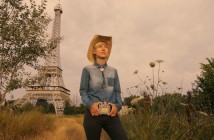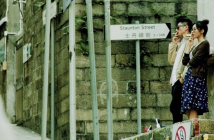Like my favorite film, also released in 1939, Renoir’s The Rules of the Game, this movie feels so modern, so fresh, and so new, that its date of release seems like some sort of ruse, a trick played on history books. And yet, it is a period film, set in 1885, concerning Kabuki theater and detailing the tribulations of a frustrated actor, all of it clad in appropriately dated clothing and shot amidst timeless architecture.
Something else places this film in some undefinable plane which makes it endlessly elusive: it is comprised almost entirely of lengthy and audacious takes, with the camera at a distance shooting a consistent stream of long-shot compositions, night images draped in shadows which sometimes obscure the expressions of the actors. Browsing through the Internet for texts on Chrysanthemums, I chanced upon the blog entry of a girl named Noemi - a “beautiful well of infinite frolic”, according to her self-portrait. She says: “Because facial features weren’t always clear, a lot of it, based on context, you imagined yourself.” This brought to my attention the oddly dreamlike vibe the film inspires. Without the immediacy forced upon me by facial expressions stretched across the dimensions of the screen, as in most movies, my eyes were able to wander through the filmed space of Chrysanthemums. More than that: the characters, without the proximity of the camera or the clarity of bright lighting, became somehow ghostlier, unreal, made tenuous by their distance, by their lack of definition. Their link to us weakened, their shape faded, they moved like the indistinct specters of a vanishing dream.
Kengi Mizoguchi apparently fell into his aesthetic fortuitously. He demanded forty-year-old Shotaro Hanayagi, an actual stage actor, to play the lead, despite the fact that his character was to be (and remained) twenty. To hide the age difference, Mizoguchi placed the camera far away from the actor’s wrinkles. But the trick didn’t work. Hanayagi is visibly too old to play the wayward son who falls for an older woman, who, incidentally, looks much younger than him. Nevertheless, what matters is that the aesthetic achieved (and was likely meant to achieve) much more than simply covering up a miscasting.
There is a beautiful scene where the protagonist, who is in love with a servant woman, has a row with his authoritarian father. The key thing to watch for is how the camera, at the moment of greatest intensity, stops caring for the discussion between father and son and locks its gaze on the mother, who is listening to the fight from an adjacent room through an open door. The row ends and the son storms out the house, but we don’t see this, only hear it, while we watch the mother’s confused posture.
Like this, the curious camera finds hidden pockets of storytelling awaiting at the corners of the screen. This is a subtle but powerful attempt to ease the hierarchical rule of the main narrative: we see, not just its own development, but also how its influence pours out of the central path, creating temporary tangents. Which is not to mean that this is some sort of ensemble drama. Rather, what the curious camera discovers are not alternatives to the main narrative, but the potential for these alternatives (which is never wholly fulfilled, and so inflames our desire for them). The universe of Last Chrysanthemums shimmers with the possibility for storytelling, and through this volatile terrain runs the narrative we happen to follow.
[notification type=”star”]95/100 - This movie feels so modern, so fresh, and so new, that its date of release seems like some sort of ruse, a trick played on history books.[/notification]




